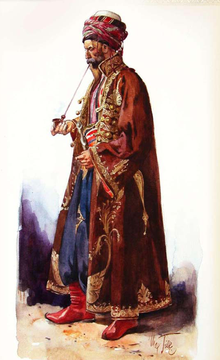
Back قفطان Arabic قفطان ARY Kaftan Azerbaijani Сапан Bashkir Кафтан Byelorussian Кафтан Bulgarian Caftan Catalan Kaftan Czech Kaftan German Kaftano Esperanto

A kaftan or caftan (/ˈkæftæn/; Arabic: قفطان, qafṭān; Persian: خفتان, khaftān; Turkish: kaftan) is a variant of the robe or tunic. Originating in Asia, it has been worn by a number of cultures around the world for thousands of years. In Russian usage, kaftan instead refers to a style of men's long suit with tight sleeves.
It may be made of wool, cashmere, silk, or cotton, and may be worn with a sash. Popular during the time of the Ottoman Empire, detailed and elaborately designed garments were given to ambassadors and other important guests at the Topkapı Palace.
Variations of the kaftan were inherited by cultures throughout Asia and were worn by individuals in Russia (North Asia, Eastern Europe and formerly Central Asia), Southwest Asia and Northern Africa.
Styles, uses, and names for the kaftan vary from culture to culture. The kaftan is often worn as a coat or as an overdress, usually having long sleeves and reaching to the ankles. In regions with a warm climate, it is worn as a light-weight, loose-fitting garment. In some cultures, the kaftan has served as a symbol of royalty.
| Part of a series on |
| Arabic culture |
|---|
 |
© MMXXIII Rich X Search. We shall prevail. All rights reserved. Rich X Search